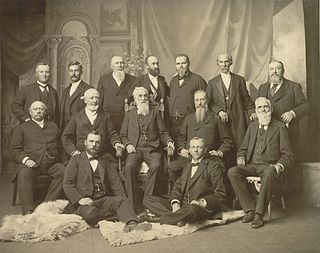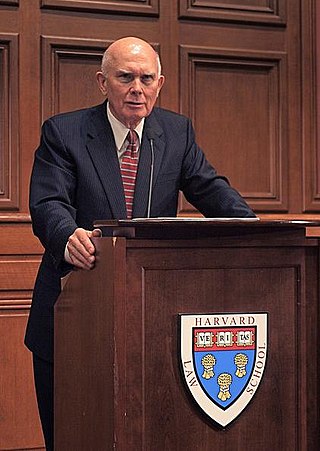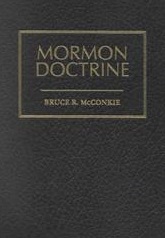In Mormonism, the Melchizedek priesthood, also referred to as the high priesthood of the holy order of God or the Holy Priesthood, after the Order of the Son of God, is the greater of the two orders of priesthood, the other being the Aaronic priesthood.
President of the Quorum of the Twelve Apostles is a priesthood calling in the Church of Jesus Christ of Latter-day Saints. Normally, the president of the Quorum of the Twelve is the most senior apostle in the church, aside from the president of the church. When the president of the church dies, it is the president of the Quorum of the Twelve who becomes the new church president. The calling of President of the Twelve has been held by 27 men. 16 Quorum Presidents have subsequently become President of the Church. Since January 2018, Dallin H. Oaks has been the President of the Quorum of the Twelve. Since Oaks is also first counselor in the First Presidency, M. Russell Ballard served as acting president until his death on November 12, 2023. Jeffrey R. Holland became the new acting president on November 15, 2023.
In the Latter Day Saint movement, an apostle is a "special witness of the name of Jesus Christ who is sent to teach the principles of salvation to others." In many Latter Day Saint churches, an apostle is a priesthood office of high authority within the church hierarchy. In many churches, apostles may be members of the Quorum of the Twelve and First Presidency of the church. In most Latter Day Saint churches, modern-day apostles are considered to have the same status and authority as the Biblical apostles.

In the Church of Jesus Christ of Latter-day Saints, the Quorum of the Twelve Apostles is one of the governing bodies in the church hierarchy. Members of the Quorum of the Twelve Apostles are apostles, with the calling to be prophets, seers, and revelators, evangelical ambassadors, and special witnesses of Jesus Christ.
In the Latter Day Saint movement, the President of the Church is generally considered to be the highest office of the church. It was the office held by Joseph Smith, founder of the movement, and the office assumed by many of Smith's claimed successors, such as Brigham Young, Joseph Smith III, Sidney Rigdon, and James Strang. Several other titles have been associated with this office, including First Elder of the church, Presiding High Priest, President of the High Priesthood, Trustee-in-Trust for the church, Prophet, Seer, Revelator, and Translator. Joseph Smith was known by all of these titles in his lifetime.
A general authority is a member of the highest levels of leadership within the Church of Jesus Christ of Latter-day Saints who has administrative and ecclesiastical authority over the church. A general authority's jurisdiction is church-wide, in contrast to the responsibilities of a local authority or an area authority, which relate to a particular area, unit, or department of the church. As a group, the general authorities are often referred to as "the Brethren". As of April 2023, The LDS listed 95 general authorities.

Richard Roswell Lyman was an American engineer and religious leader who was an apostle in the Church of Jesus Christ of Latter-day Saints from 1918 to 1943.

Matthias Foss Cowley was a member of the Quorum of the Twelve Apostles of the Church of Jesus Christ of Latter-day Saints from 1897 until 1905. He resigned from the Quorum of the Twelve due to his unwillingness to support the church's abolition of plural marriage. He and John W. Taylor are the most recent apostles of the LDS Church to have resigned from their positions.
In the Latter Day Saint movement, there are two presiding high councils, one said to be "standing," and the other "traveling." The traveling high council is generally known as the Quorum of Twelve Apostles. Both councils, at least in theory, preside over the church, although the apostles have tended to supersede the standing high council in both of the largest Latter Day Saint denominations, The Church of Jesus Christ of Latter-day Saints and the Community of Christ.

The First Presidency, also called the Quorum of the Presidency of the Church or simply the Presidency, is the presiding governing body of the Church of Jesus Christ of Latter-day Saints. It is composed of the President of the Church and his counselors. The First Presidency currently consists of Russell M. Nelson and his two counselors: Dallin H. Oaks and Henry B. Eyring.
In the Latter Day Saint movement, the Quorum of the Twelve is one of the governing bodies of the church hierarchy organized by the movement's founder Joseph Smith and patterned after the Apostles of Jesus. Members are called Apostles, with a special calling to be evangelistic ambassadors to the world.
The Presiding Bishop of the Church of Jesus Christ of Latter-day Saints is a priesthood calling with church-wide authority. The Presiding Bishop is the highest leadership position within the church's Aaronic priesthood, although most of the work in this area is delegated to the church's Young Men general presidency.

Mormon Doctrine is an encyclopedic work written in 1958 by Bruce R. McConkie, a general authority of the Church of Jesus Christ of Latter-day Saints. It was intended primarily for a Latter-day Saint audience and has been used as a reference book by church members because of its comprehensive nature, and was a highly influential all-time bestseller in the LDS community. It was viewed by many members both then and now as representing official doctrine despite never being endorsed by the church. It has been both heavily criticized by some church leaders and members and well regarded by others. After the book's first edition was removed from publication at the instruction of the church's First Presidency and Quorum of the Twelve, corrections were made in subsequent editions. The book went through three editions but has been out of print since 2010.
Assistant President of the Church was a position in the leadership hierarchy in the early days of the Latter Day Saint church founded by Joseph Smith. The Assistant President was the second-highest authority in the church and was a member of the church's governing First Presidency. As President of the Church, Smith appointed two men to serve in the position of Assistant President. After Smith's death, most Latter Day Saint denominations discontinued the position of Assistant President of the Church.
In the Latter Day Saint movement, the Common Council of the Church is a body of the church that has the power to discipline or remove the President of the Church or one of his counselors in the First Presidency due to misbehavior. Its existence and status are uncertain and controversial, and the body has only been formally convened twice, once to try Joseph Smith in 1834 and once in 1844 when Sidney Rigdon was excommunicated in absentia. The Common Council of the Church is sometimes confused with the Council of the Church.
An organization is a secondary body of church government within the Church of Jesus Christ of Latter-day Saints that is "established for moral, educational, and benevolent purposes." Prior to October 2019, the church's organizations were called auxiliary organizations. As the term suggested, the LDS Church's organizations are ancillary to the governing power of the priesthood in the church. The LDS Church's five organizations are Primary, Relief Society, Sunday School, Young Men, and Young Women.
The 1978 Revelation on Priesthood was an announcement by leaders of the Church of Jesus Christ of Latter-day Saints that reversed a long-standing policy excluding men of Black African descent from the priesthood and both Black men and women from priesthood ordinances in the temple. Leaders stated it was a revelation from God.

The President of the Church is the highest office of the Church of Jesus Christ of Latter-day Saints. It was the office held by Joseph Smith, the church's founder. The church's president is its leader and the head of the First Presidency, its highest governing body. Latter-day Saints consider the president of the church to be a "prophet, seer, and revelator" and refer to him as "the Prophet", a title that was originally given to Smith. When the name of the president is used by adherents, it is usually prefaced by the title "President". Russell M. Nelson has been the president since January 14, 2018.
Apostolic succession in the Church of Jesus Christ of Latter-day Saints is the process of transition to a new church president when the preceding one has died.




